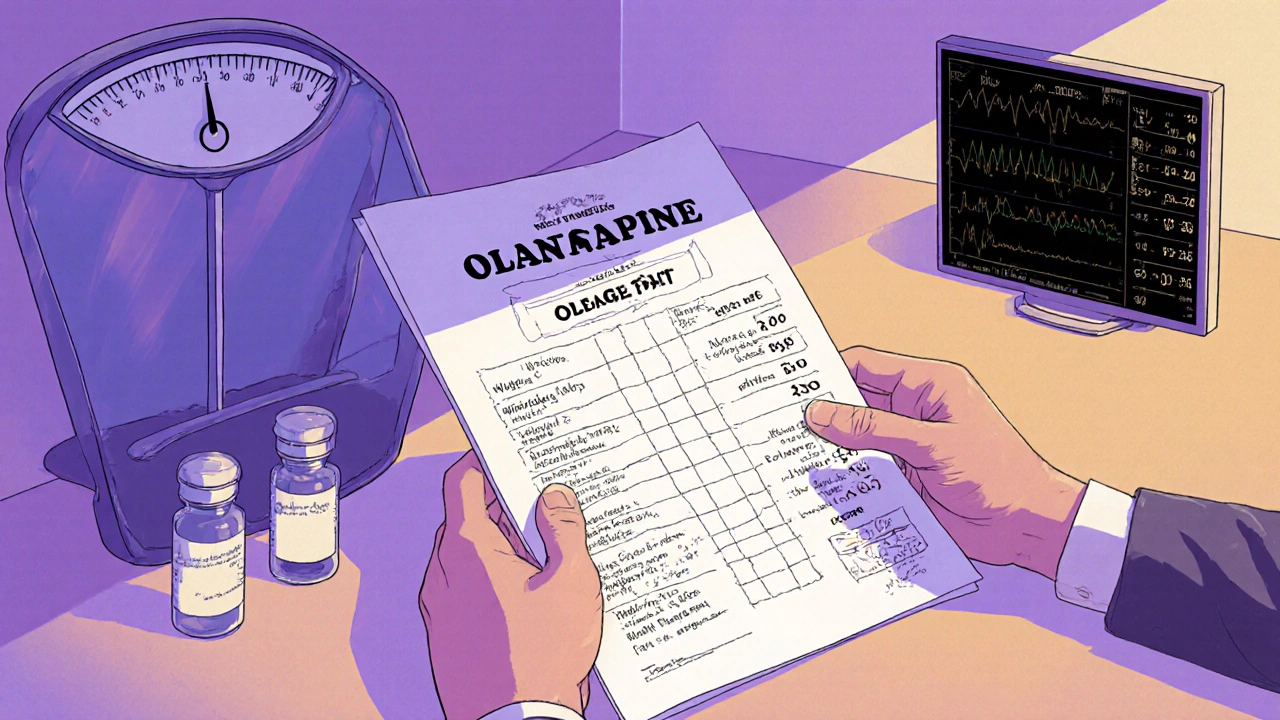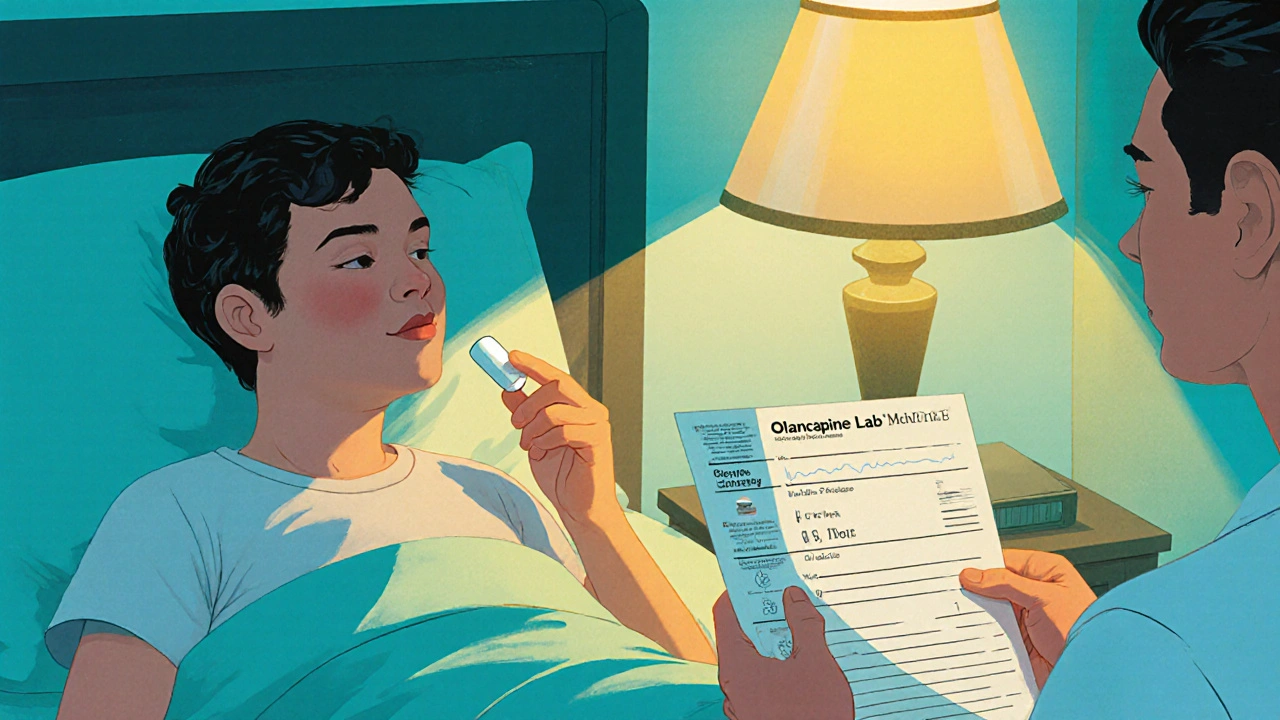Olanzapine Dose Calculator
Dosing Guide
This calculator helps determine the appropriate Olanzapine dose based on patient weight and clinical scenario.
5 mg for <60 kg, 10 mg for ≥60 kg
5-10 mg daily
When managing acute agitation and aggression, Olanzapine is a second‑generation antipsychotic that many clinicians turn to for its rapid calming effect. This article walks through why Olanzapine works, how to dose it safely, and what to watch out for, so you can decide if it fits the situation you’re facing.
Understanding Acute Agitation and Aggression
Acute agitation describes a sudden surge of restlessness, irritability, or hostile behavior that can jeopardize patient safety. It often stems from psychiatric conditions like schizophrenia or bipolar disorder, but can also appear in delirium, substance‑induced states, or after traumatic brain injury. When agitation escalates to aggression, the risk of harm grows, making timely pharmacologic intervention essential.
What Is Olanzapine?
Olanzapine belongs to the atypical antipsychotic class. Approved by the FDA in 1996 for schizophrenia and bipolar mania, it blocks dopamine D2 receptors and serotonin 5‑HT2A receptors. This dual action lowers psychotic symptoms while preserving mood stability, which explains its popularity in emergency settings where rapid calming is needed.
Why Olanzapine Calms Aggression
Blocking dopamine D2 receptors reduces the over‑active mesolimbic pathway that drives agitation. At the same time, antagonism of serotonin 5‑HT2A receptors moderates mood and anxiety circuits, smoothing out the emotional spikes that often lead to aggression. The combined effect typically yields noticeable sedation within 30‑45 minutes after an intramuscular (IM) dose.

Clinical Evidence Supporting Use
A 2022 multicenter trial involving 312 patients with emergency‑room agitation showed that a single 10 mg IM dose of Olanzapine achieved calmness in 71% of cases, compared with 58% for haloperidol and 53% for risperidone. Another meta‑analysis of ten studies confirmed a lower incidence of extrapyramidal symptoms with Olanzapine versus typical antipsychotics, while maintaining comparable efficacy.
Practical Dosing Guidelines
- Initial IM dose: 5 mg for patients under 60 kg, 10 mg for larger adults.
- Oral route: 5‑10 mg once daily for less severe agitation; can be escalated to 20 mg if needed.
- Maximum daily dose: 20 mg for most adults; higher doses increase metabolic risk.
- Repeat dosing: If calmness is not achieved after 30 minutes, a second identical IM dose may be given, but avoid exceeding 20 mg total in a 24‑hour period.
Always monitor vital signs, especially heart rate and blood pressure, as Olanzapine can cause orthostatic hypotension.
Comparing Olanzapine with Other Antipsychotics
| Drug | Typical Onset | Common Dose (IM) | Key Side Effects |
|---|---|---|---|
| Olanzapine | 30‑45 min | 5‑10 mg | Weight gain, sedation, metabolic changes |
| Haloperidol | 15‑30 min | 5‑10 mg | Extrapyramidal symptoms, QT prolongation |
| Risperidone | 30‑60 min | 1‑2 mg | Prolactin elevation, EPS at high doses |
| Quetiapine | 45‑60 min | 25‑50 mg | Orthostatic hypotension, sedation |
The table highlights that Olanzapine offers a balance between rapid calmness and a more tolerable side‑effect profile compared with typical agents like haloperidol.

Safety Profile and Monitoring
While Olanzapine is generally well‑tolerated for short‑term use, clinicians should keep an eye on:
- Metabolic parameters (glucose, lipids) if treatment extends beyond a few days.
- Excessive sedation that may compromise airway protection.
- Potential for QTc prolongation, especially when combined with other cardiotoxic drugs.
Patients with pre‑existing diabetes or severe cardiovascular disease may need alternative agents or lower dosing strategies.
Tips for Clinicians and Caregivers
- Assess the root cause of agitation before selecting medication - a medical work‑up can uncover delirium or infection.
- Start with the lowest effective IM dose; adjust based on weight and response.
- Document the exact time of administration; rapid reassessment (within 30 minutes) prevents over‑sedation.
- Educate family members about possible side effects and the need for follow‑up labs if the drug is continued.
- Consider transitioning to an oral regimen once calmness is achieved to avoid repeated injections.
These steps help maximize benefit while minimizing risk, especially in busy emergency or psychiatric units.
Frequently Asked Questions
Can Olanzapine be used for children with aggression?
Olanzapine is FDA‑approved for adolescents 13 years and older with schizophrenia or bipolar disorder. For acute aggression, off‑label use is possible, but clinicians must weigh metabolic side effects carefully and obtain parental consent.
How does Olanzapine compare to benzodiazepines for agitation?
Benzodiazepines act on GABA receptors and provide fast sedation, but they do not address underlying psychosis. Olanzapine offers both sedative and antipsychotic effects, making it a better choice when agitation is tied to a psychotic process.
Is an IM injection necessary, or can I give Olanzapine orally?
If the patient is cooperative, an oral dose works well. In cases of severe resistance or when rapid control is critical, the IM route ensures absorption and faster onset.
What are the main metabolic concerns with Olanzapine?
Weight gain, increased fasting glucose, and elevated triglycerides are the most common. Baseline labs and periodic monitoring can catch changes early.
Can Olanzapine be combined with other antipsychotics?
Combination therapy is generally discouraged due to additive side effects, especially cardiac and metabolic risks. If additional control is needed, clinicians usually switch agents rather than stack them.

hema khatri
October 23, 2025 AT 12:36Olanzapine is the perfect weapon for our hospitals-fast, effective, and no nonsense!!! It calms even the most chaotic rooms with just a single shot!!!
Jennell Vandermolen
October 28, 2025 AT 02:43Thanks for sharing the quick‑action insight; it’s useful to remember that dosing should still be weight‑adjusted to keep safety front‑and‑center.
Mike Peuerböck
November 1, 2025 AT 17:50It is essential to contextualize the pharmacodynamic profile of olanzapine within the broader therapeutic arsenal. The dopamine blockade mitigates the hyperactive limbic surge that fuels agitation. Simultaneously the serotonin antagonism tempers affective turbulence. Clinicians observing a rapid onset may attribute it to the lipid solubility of the formulation. The intramuscular delivery bypasses first‑pass metabolism and yields measurable plasma levels within minutes. Evidence from the 2022 multicenter trial underscores a seventy‑one percent calmness rate. Comparative analyses reveal a lower extrapyramidal burden relative to typical agents. Nonetheless vigilance for metabolic perturbations remains paramount. Baseline glucose and lipid panels are advisable before repeated administration. Monitoring blood pressure and heart rate safeguards against orthostatic events. In patients with cardiac comorbidities, electrocardiographic surveillance mitigates QTc concerns. The recommended ceiling of twenty milligrams per day balances efficacy with risk. Titration should be guided by clinical response rather than a rigid schedule. Documentation of administration timestamps facilitates audit trails and quality improvement. Ultimately, judicious use of olanzapine can enhance patient safety while preserving therapeutic momentum.
Simon Waters
November 6, 2025 AT 08:56Olanzapine works quickly, but watch for weight gain and blood sugar changes later.
Bonnie Lin
November 11, 2025 AT 00:03Start low, watch vitals, and switch to oral once calm.
Abhishek Kumar
November 15, 2025 AT 15:10Sounds fine.
Danielle St. Marie
November 20, 2025 AT 06:16Only the truly elite prescribe olanzapine without fearing metabolic fallout 😎💊 – the rest are stuck with outdated antipsychotics.
keerthi yeligay
November 24, 2025 AT 21:23I think the article is good but the typos like "safety profil" need fix.
Peter Richmond
November 29, 2025 AT 12:30Your observation is noted; ensuring editorial accuracy upholds the professional standard we all expect.